Boat Speak
Terms we use to describe our designs. This glossary was originally published in our WebLetters. If you have any suggestions for additions, or corrections, please email: webmaster@glen-l.com
The following was recommended by a customer as a source of definitions for traditional sea terms. Transcribed by Christopher Morrison, December 1997
“Dictionary of Sea Terms”. 1841/1851 – From “The Seaman’s Friend: Containing a Treatise on Practical Seamanship, with Plates; A Dictionary of Sea Terms; Customs and Usages of the Merchant Service; Laws Relating to the Practical Duties of Master and Mariners.
by R. H. Dana, Jr. author of “Two Years Before the Mast”. The Sixth Edition, Revised and Corrected, Boston: Thomas Groom & Co., 1851.
A
- AFT
- Toward the stern.
- AIR-DRIED LUMBER
- Lumber or other wood products that have been either dried by exposure to natural atmospheric conditions outdoors or in an unheated shed. Wood that is dried to equilibrium with the surrounding atmosphere. Moisture content of air-dried wood fiber depends on relative humidity, temperature, and length of drying period. Also referred to as air seasoned and contrasts with kiln-dried (KD) lumber.
- AMINE BLUSH
- Most epoxies used in boatbuilding have “amine”-based hardeners. After the epoxy is cured there will usually be a noticeable oily residue on the surface called amine blush. The amount of amine blush can vary considerably, from almost unnoticeable to very oily. This difference is the result of differences in temperature and humidity. The amine blush can affect the bond of subsequent coats of epoxy or paints and should be removed. Although a variety of solvents have been used to remove amine blush, in the shop we use denatured alcohol (shellac thinner), laquer thinner or acetone. Amine blush can be sanded off, but will require a lot of sandpaper as the paper tends to clog quickly.
- ANTI-TRIP CHINE
- A flared out aft section of the side/bottom of the boat. The purpose is to prevent the hard chine of the boat catching a wake or small wave on a sharp turn.
- ASPECT RATIO
- The relationship between the height of a sail and its breadth. i.e. A sail with a height of 30′ and a breadth of 20′ has an aspect ratio of 3:2.
- ATHWARTSHIP(S)
- Across the boat.
- BACKSTAY
- A wire-rope from the top of the mast leading aft to prevent the mast from bending forward.
- BALLAST
- Weight carried low in a boat to increase stability. The lower, the greater the benefit. Ballast can be lead, iron, concrete, etc., depending on the space available. Some boats require lead (a more expensive material) because the space available will not allow sufficient lighter material to achieve the required ballast weight.
- BATTENS
- Thin semi-rigid strips of wood or synthetic material inserted into pockets in the sail in order to maintain the shape of the sail. Interior longitudinal reinforcements in a boat hull. Most often located on either side of the keel, running as far forward as possible. Battens are also used to reinforce the sides of some hulls.
- BEAM
- Width, generally the widest point on the hull, but beam could be given at any point in the hull. “The beam at the transom, at frame number three.” The beam is sometimes given as though the hull were a rectangle. “The James Cook: a 27′ x 8′ trailerable cruising sailboat.”
- BLOCK
- A wood, metal, or synthetic casing containing one or more pulleys or sheaves.
- BIMINI
- Sun shade. A bimini provides protection from the sun. It is commonly made from fabric mounted on a collapsable frame.
- BOARD FOOT
- A lumber measurement. One board foot = 1″ X 12″ X 12″. A piece of lumber 2″ X 12″ X 12″ = 2 board feet. When width and thickness are specified, lumber may be called out as linear feet, i.e., 1″ X 6″ X 24 linear feet. Linear feet is used when the the lumber will be cut into various lengths, as opposed to a piece 1″ X 6″ x 24′ which would be a single piece of wood.
- BOBSTAY
- A chain, wire-rope, or rod supporting a bowsprit or boomkin against upward pull.
- BOLTROPE
- Rope sewn along one or more edges of a sail to strengthen it and take some of the stress of the cloth when it is stretched tightly.
- BOOKMATCH
- A term in veneering, where successive pieces of veneer from a flitch are arranged side by side. A properly done bookmatch will resemble a mirror image of the opposite side.
- BOOM
- The pivoting horizontal “pole” attached to the aft side of the mast to control the foot of the sail.
- BOOMKIN
- A spar projecting from the stern to which is attached a backstay or sheet.
- BOOT TOP
- A panted line, just above the waterline.
- BOTTOM SHAPE
- As it affects performance in a planing boat. Maximum speed will be achieved when the bottom of the boat that forms the planing surface is flat. When the planing surface is a vee, the boat will have a softer ride but less potential speed, and will take longer to come up on a plane. A “flat bottom” makes a better “drag” boat, a deep vee will be a better rough water boat.
- BOW (as in bow-wow, not bow tie)
- The front of the boat. “I am going to stand in the bow so I can watch the porpoises”.
- BOWSPRIT
- A tapered pole extending forward of the bow of a sailboat to which the forestay fastens. The purpose being to increase the amount of sail area without raising the center of effort.
- BREASTHOOK
- A knee which mounts atop the stem, to which the sheers attach.
- BRIGHT WORK
- A term used to describe wood that is finished natural, using varnish or other clear coating.
- BROADSEAM
- A seam in a sail, in which the edges of neighboring panels are cut in a convex curve, so that when sewn together the panels force fullness into the sail.
- BULBOUS FOREFOOT
- A convex entry at the keel/stem junction (as opposed to a sharp vee) incorporated to soften the ride. When used in conjunction with a reverse curve at the chine, it usually makes sheet materials impractical requiring other planking methods in the forward section.
- BULKHEAD
- A vertical, athwartship partition, most often serving as a set-up member or frame.
- BULWARK
- An extension of the planking above the deck to form a rail.
- BURGEE
- A triangular shaped flag denoting the yacht club to which the owner belongs.
- BUTT
- Buttock. Used for developing the lines of a boat. Used only for lofting the lines to full size; not required when patterns are supplied.
- CAMBER
- Athwartship curve of the vessel’s deck or cabin top. Curve. Sail term: The fore and aft curvature of a sail in relation to its chord.
- CAT RIG
- See SAILBOAT RIGS.
- CARLING
- A longitudinal structural member at the cockpit perimeter supporting the inboard side of the side deck. (See COAMING)
- CARVEL PLANKING
- Solid wood planks, butted together, fastened to the frames, with a flexible caulking between the planks. Should not be fiberglassed.
- CATAMARAN
- A vessel with two parallel hulls.
- CAVITATION
- Essentially, to suck air. This term is primarily used in conjunction with propellers and rudders. When cavitating, the propeller will speed up, but power is lost; the rudder may lose steering action. Cavitation most often occurs when turning. Both result from a loss of a constant solid water flow. Power catamarans usually require deflectors when a single motor is used, to direct a flow of water to the propeller. Webster’s Dictionary: “the formation of partial vaccums in a flowing liquid as a result of a separation of its parts”. i.e. aeration of the liquid.
- CENTERBOARD
- A pivoting “keel” that retracts into a case inside a sailboat. Used to prevent leeway.
- CENTERBOARD LIFT
- A line or cable for raising and lowering the centerboard on a sailboat.
- CENTER OF EFFORT (CE)(Sail)
- The fore and aft and up and down point on a sail at which the pressure of the wind is concentrated. The geometric center of the sail. The higher CE, the more leverage the wind has to heel the boat. When there is more than one sail, CE’s will be given on the drawing for each sail plus a combined CE. On a triangle, the CE is the point at which the lines bisecting each angle cross. The location of the CE fore and aft, affects the way the boat turns into the wind. (See LEE and WEATHER HELM)
- CENTER OF LATERAL RESISTANCE (CLR)
- The geometric center or pivot point of the underwater hull profile.
- CHAINPLATE
- A metal strap to which shrouds or fittings are attached.
- CHECKING (in wood)
- Longitudinal separation of the fibers in wood that do not go through the whole cross section. Checks result from tension stresses during the drying process.
- CHINE (Chine log)
- The junction of the side and bottom planking or the member backing this junction.
- DOUBLE CHINE – Having an additional planking junction between the chine and the sheer, giving the hull a more rounded look.
- HARD CHINE- Having a distinct bottom/side planking junction as opposed to a rounded curve.
- MULTI-CHINE – Having one or more additional planking junctions between the chine and the sheer.
- CLEW
- The lower, aft corner of a fore-and-aft sail, where the leech meets the foot.
- CHORD
- A straight line between the luff and leech of a sail.
- CLINKER – See PLANKING METHODS-WOOD: Clinker
- CLIPPER BOW
- A bow where the stem has a forward curve and sides have a lot of flair. Also called a schooner bow.
- COCKPIT
- “In small decked vessels, a sunken space toward the stern used by the helmsman.” …Webster’s New World Dictionary.
More commonly, in a boat, this refers to the outside working or seating area below the sheer. Bow riders have a forward cockpit. On a center console, the inside area could be called a cockpit, but this term is more often used to define a more limited area.
- CROSSCUT
- Sails in which the panels of cloth run perpendicular to the leech.
- CLUB-FOOTED JIB
- A jib with a boom or “club” on the foot of the sail.
- COAMING
- A non-structural longitudinal member at the cockpit perimeter; a decorative piece fastened to the carling, usually protruding above the side deck to prevent water from entering the cockpit.
- CRINGLE
- A metal ring or grommet around a hole in the sail for reinforcement.
- CRUISER
- (Power boat) A boat with certain minimum appurtenances for living afloat. These are sleeping accommodations, cooking facilities, a toilet, some lounging space, and fuel and water tanks. The terms sedan, express, and day are loose categories meant to place emphasis on certain capabilities. A sedan cruiser has more glass and more lounging area,express is faster, and a day cruiser has minimal accommodations and usually only practical for limited overnight stays.
- CUNNINGHAM
- A line device or cringle located several inches above the tack of the sail; used with a downhaul to control the tension along the luff and hence the shape of the sail. Primarily used in competition craft.
- CUTTER RIG
- See SAILBOAT RIGS.
- DAGGERBOARD
- A blade shaped centerboard that is lifted out of a case when raised. Usually only suitable for small boats.
- DEAD-RISE
- Looking at the hull in cross section, the angle the bottom rises from a horizontal.
- DEEP VEE
- A hard chine power boat having a 15 degree or more angle deadrise at the transom.
- DISPLACEMENT HULL
- A hull that will not exceed a fixed speed which increases with the length of the hull. Additional power will only allow a hull to maintain hull speed against a head wind or under load. (See PLANING HULL)
- DORY
- The traditional dory is a small, flat-bottomed fishing boat with high flaring sides, and considerable sheer. The commercial fishing dories of New England were stacked on a larger boat and transported to the Grand Banks where they were off-loaded with a fisherman, and later retrieved. The boats were noted for their sea worthiness. The term “dory” appears to have come from an Indian term for a dugout. Over the years the dory has evolved to encompass various types of boats, usually characterized by flat bottoms and flaring sides. Some of the “improvements” of previous models have made them hard to recognize as dories. The “Pacific Dory” has a flat bottom, flaring sides, a wide transom and is capable of planing. The following designs are classified as dories: DORY, LUCKY PIERRE, BIG/LITTLE/WEE HUNK, HUNKY DORY, and ALPHA 2.
- DOUBLE HEADSAIL RIG
- Two sails forward of the mast as in a cutter.
- DAVITS
- Curved uprights projecting over the side of larger boats for suspending, or raising and lowering a smaller boat.
- DRAFT
- The depth of water a boat can travel over without hitting the bottom.
- DRY ROT
- A fungous decay causing seasoned lumber to become brittle and crumble to powder. Dry rot needs extended periods of moisture (fresh water), oxygen, and dry rot spores to thrive.
- FAIRING
- The process of beveling the stem, chine, sheers, keel, and frames so that the planking will have flat surfaces to glue and fasten to. A “fair” hull is one with no dips or bumps in the longitudinal lines of the hull. Fairness is checked by sighting down the longitudinal lines. (See BOATBUILDING METHODS/Plywood for more information.)
- FIDDLE
- A frame or railing on a boat’s table to keep dishes, etc. from falling off in rough weather. Fiddles are frequently left open at the corners for drainage.
- FILL
- The thread that runs across sail cloth from edge to edge.
- FILLET/FILLETING
- A fillet is a cove shape made with putty on an inside corner. The term is most often used in reference to Stitch-N-Glue boat building. A fillet is made with activated epoxy resin, thickened with various fillers, to a putty consistency. The putty is “globbed” into place and smoothed with a rounded tool. (See Boatbuilding Methods: Stitch-N-Glue.)
- FLOOR TIMBER
- A scab that joins two-part bottom frames at the centerline.
- FLITCH
- A log sawn on two or more sides from which veneer is sliced.
- F.O.B.
- This is a shipping term, not a boat term. It means “freight on board”, or that the shipper will put the freight on a truck, but the consignee pays shipping charges.
- FOOT
- The lowest edge of a sail.
- F.P.
- “Forward perpendicular”. This is an naval architecture term. It will usually be seen on the #2 plansheet, where the various stations are shown. This represents the end of the stem, or the last station from the transom.
- FORETRIANGLE
- The area forward of the forward mast in which sails can be set. A sail that fills that area.
- FRAMES
- Athartship members (ribs) of the hull framework. Frames can be divided into two categories: sawn or bent frames. Sawn frames are assembled from separate pieces, either lapped or gusseted together to form the station contour. Bent frames are bent around a form or into a hull using one or more layers of solid wood. No Glen-L designs use bent frames. Frames can be lapped with a piece of plywood filling the interior frame space to form a bulkhead.
- SHAFT HORSEPOWER (SHP)
- FREEBOARD
- The distance from the water to the sheer.
- GAFF RIG
- See SAILBOAT RIGS.
- GARVEY HULL
- A hard chine hull in which the chines do not join on the stem centerline. (See PLAY PEN design)
- GARBOARD
- The plank adjoining the keel. Also called garboard strake. Garboard drain plugs are installed at the lowest point along the garboard.
- GEL COAT
- A semi-thixotropic, air-inhibited, usually pigmented resin that is applied to a waxed mold surface over which subsequent fiberglass layup is made. When the piece is removed from the mold, the gel coat becomes the outside finish.
- GENOA
- A large, low cut, jib that overlaps the mast.
- GOOSENECK
- A fitting used to attach the boom to the mast and which permits the boom to pivot. Also, the body part between the head and the body of a goose; most often used for making gravy.
- GUDGEONS AND PINTLES
- Hardware used to connect an “outboard” rudder to the back of the boat. The pintle has a pin (male part), The gudgeon accepts the pintle (female part). There are different styles, sometimes with the pintle on the rudder, sometimes on the transom.
- GUNKHOLING
- Cruising in shoal water or overnighting in small coves.
- GUNWALE (GUNNEL)
- Originally applied to the bulkheads that supported a ship’s guns; the upper edge of the side of a boat. Is frequently used interchangeably with SHEER.
- GUSSET
- A scab that joins the side and bottom frame members at the chine.
- HALYARD
- A line used to raise and lower the sails. External halyards are located outside the mast; internal halyards pass through the inside of a hollow mast.
- HANK
- A metal or nylon clip used to hold the luff of a headsail or staysail to the forestay.
- HARDWOOD
- A description applied to woods from deciduous broad-leafed trees (Angiosperms). The term has no reference to the actual hardness of the wood. Hardwoods have traditionally been used in making such products as furniture, strip flooring, interior trim, boats, cutting boards, novelties, etc. Wood used in making these products is typically in the form of relatively small and defect-free pieces which are subsequently glued together; it is also generally more costly than wood from softwood species. Because of these factors, hardwood lumber is manufactured to non-standardized length and width dimensions which will minimize trim waste. For the same reasons, such lumber is measured relatively accurately, with rounding of measurements in small increments.
- HARPIN
- A sheer sawn to shape as opposed to being bent to shape around the frames. The harpin may be only a portion of the sheer (usually the forward section) or the complete sheer. Glen-L supplies a pattern or dimensions for the harpin.
- HEAD (Re: Sail)
- The top edge of a four sided sail or the top corner of a triangular sail.
- HEARTWOOD
- The wood making up the center part of the tree, beneath the sapwood. Cells of heartwood no longer participate in the life processes of the tree. Heartwood may contain phenolic compounds, gums, resins, and other materials that usually make it darker and more decay resistant than sapwood.
- HOOK (re. boat bottom)
- This is one of two conditions in the bottom of a planing boat that can lead to performance problems. When the boat is rightside-up, the bottom curves up from the transom; is “dished” forward of the transom. This “hook” will drive the bow down, reducing performance. Can also lead to the bow “bobbing” up and down. The aft section of the hull, seen in profile, should be straight. See ROCKER
- HOUND
- A wraparound mast fitting used to secure the forestay and other fittings to the mast on a jibhead rig.
- HOUSE
- Apart from the obvious meaning, this is a term applied to the cabin on a boat.
- I/O (Inboard/outboard)
- A propulsion system that uses an inboard motor, mounted at the transom, with a propeller assembly, similar to the bottom of an outboard, mounted on the outside of the transom, bolting to the motor with the transom sandwiched between. Also called a stern drive. In most designs it can be used optionally to a v-drive, or jet drive.
- IN-LINE INBOARD ENGINES
- A centrally mounted inboard, with the prop shaft usually coming directly off the engine or transmission; in-line with the engine.
- JIB
- A triangular sail forward of the forward mast, usually attached to the forestay.
- JIBHEAD RIG
- In a jibhead rig, the forestay does not attach to the masthead, but at a point lower on the mast where the top of the jib meets the mast.
- KEEL
- The junction of the bottom planking along the centerline of the boat or the inside member backing this junction aft of the stem. The term also refers to an outer longitudinal appendage on the centerline. The purpose of this member is to keep the wind from blowing the boat sideways from its forward course. The keel also serves to protect the prop on a power boat.
- KERF
- The cut made by a saw blade.
- FIXED KEEL – Usually associated with a sailboat, this is simply a non-retractable keel. A fixed keel trailerable boat requires a special trailer and special launch facilities.
- KETCH RIG
- See SAILBOAT RIGS.
- KILN
- In lumber drying, a kiln is a room or building where temperature, moisture, and the amount of air circulating are controlled to dry wood.
- KILN DRIED
- (KD) Freshly cut green lumber may be sold green or first dried in a kiln to accelerate removal of the moisture in the wood. Drying wood in a kiln is an art to ensure that the wood dries evenly to retain its strength and aesthetic properties. Different species dry at different rates. Kiln dried lumber commands a higher price than green or air dried lumber.
- KNEE
- A brace or reinforcement between two joining planes. On our boat designs, knees are used to reinforce the junction between the bottom and the transom, between the sides and transom.
- KNOT SPEED CONVERSION
- To convert to miles per hour, use the following formula: speed in mph = speed in knots divided by .87.
- LAPSTRAKE – See PLANKING METHODS-WOOD: Clinker
- LATEEN RIG
- See SAILBOAT RIGS.
- LAUNCH
- A large, open motorboat.
- LEAD
- The distance between the CLR and the CE of a vessel. (Pronounced “leed”.)
- LEATHERS
- Pieces of leather that are stitched and/or tacked around an oar to protect it where it rides in the oar lock. They usually have a stop or “button” to keep the oar from sliding out of the oar lock when left unattended. The button can be a thin strip of leather or knotted twine that is tacked and/or glued in place on top of the leather at the handle end of the oar.
- LEEBOARD
- These are paddle-shaped boards installed on the outside of the gunwale on each side of a sailboat. The board on the “lee” side is lowered to prevent leeway. Single leeboards are used as a way of converting a non-sailing boat to sail without the necessity of cutting holes in the hull or installing permanent outside keels.
- LEECH
- The aft most or back edge of a sail.
- LEE HELM
- A condition in which the tiller must be held toward the downwind side of a sailing vessel in order to maintain course. An undesirable condition for safety and hydrodynamic reasons. (See WEATHER HELM)
- LEEWARD
- On a hull, the side away from the direction of the wind; the protected side. In the days of sailing ship warfare, you wanted your opponent in your lee (to leeward) which took his wind and gave you the advantage.
- LEEWAY
- To drift from course in the direction of the wind.
- LIFT STRAKES
- Longitudinal members running fore and aft on the outside bottom of the hull. The purpose is to stabilize and create lift on a deep vee hull when under power.
- LIMBER
- A hole or channel that allows water to drain to the lowest point in the hull. Limbers can be through frames, usually at the keel or other longitudinal, can also be cut through longitudinals.
- LOFTING
- Lofting is the process of drawing the hull lines full size from the designer’s scale drawings. The intersections of the contours of various horizontal and vertical sections are measured from an imaginary “base line” using an architect’s scale. These junctions are then laid out, point by point, in their full size. Because it is difficult to take accurate dimensions from a small drawing, it is necessary to adjust these lines to assure that they are “fair”. A listing of these points is called a table of offsets. It takes a lot of space to loft. This, along with the difficulty, makes it a daunting task and a real drag to those builders who just want to get at the “wood”. All GLEN-L designs have full size patterns… no lofting required.
- LONGITUDINALS
- Those hull framing members that run the length of the boat (i.e. chine, keel, sheer, battens).
- LUFF
- The front or leading edge of a sail.
- LUMBER
- Lumber is simply solid wood that has been sawn to a particular size. Traditionally produced from very large diameter logs, lumber is now often made from logs as small as 8 to 12 inches (20 to 30 cm) in diameter. A variety of equipment is used to produce lumber. Newer mills that process softwood logs combine scanners, computers to calculate optimium sawing sequences, and high speed, thin-kerf saws designed to obtain maximum lumber yield. The newest “lumber” products are not lumber at all in the traditional sense, but composite products created from veneers, thin flakes, or other materials such as plastic. Such products have more uniform strength properties than solid-sawn wood and can be made to large sizes even when using small trees as raw material. Lumber is always measured, bought, and sold based on nominal, rather than actual, sizes. Measurements are affected by moisture content and, in the case of hardwoods, by whether boards are surfaced or unsurfaced.
- MASTHEAD RIG
- The forestay attaches to the masthead.
- MILL CHIPS
- After debarking and before a sawmill cuts lumber, it saws off the outer four slabs to reduce the log to a square or rectangular shape. The slabs are mostly the sapwood portion of the log and may be resawn to save low quality boards (e.G., Pallet boards), or the slabs are sent to the chipper. Most chippers pass their chips over a two-deck vibrating screen to separate the “overs,” “accepts” and “fines.” The “overs” are re-circulated through the chipper again and the “fines and sawdust” are blown into their own pile. The chip “accepts” are blown into a pile for processing into wood products.
- MIZZEN
- A sail aft of the aft mast on a multi-masted boat.
- MOISTURE CONTENT
- Weight of the water within a piece of lumber measured as a percentage of the weight of the dry wood. Typical moisture content for kiln dried construction lumber is 15%. Wood absorbs or gives off moisture depending on the ambient moisture in the air. The percentage of wood that is not moisture is referred to as “dry solids,” that is, dried construction lumber would be 85% dry solids. Product standards for lumber manufactured in the United States are developed under the jurisdiction of the U.S. Department of Commerce and administered by the American Lumber Standards Committee (ALSC). Members of the ALSC are representatives of various softwood lumber trade associations. As specified in the ALSC American Softwood Lumber Standard, softwood lumber is sold as “dry” if at a moisture content of 19% or less. Most hardwoods manufactured in the United States are produced to standards developed by the National Hardwood Lumber Association (NHLA). No single moisture content, however, is specified for hardwoods because the uses are more specialized. The moisture content must be specified by the buyer and agreed to by the seller; a 10% moisture content specification is common.
- MONOCOQUE
- A structure in which the outer covering (planking) carries all or a major part of the stresses.
- MONOHEDRON
- From the Greek word hedron (a geometrical figure having any number of planes). The theoretical ideal shape for planing over the water surface is one of constant (mono) section. Thus monohedron describes a hull that has a running surface of constant section; in practice the sections may not be exactly the same.
- MOTORSAILER
- A combination of sailboat and motorboat; a compromise, neither the ideal sailboat or powerboat.
- MOTOR WELL
- When an outboard motor is mounted on the transom, a motor well is a box-like structure in front of the motor that catches water that may wash over the outboard cut-out and allows it to drain over the transom and not into the boat. When a motor is mounted in front of the transom, motor well refers to a box-like structure that surrounds a hole in the bottom of the boat. The well usually allows the motor to tilt up, frequently through a cut-out in the transom. This type of motor well allows the handling of nets or fishing lines over the transom without having to work around the motor.
- OAR LOCKS (ROWLOCK
- A device for holding an oar in place when rowing or steering. The majority of commercially available oar locks consist of a “socket” and a “horn”. The horn can be U-spaped or round. In the past various other systems of holding the oar have been used. See THOLE.
- OFFSETS
- Measurements supplied by a designer for the builder in order to lay down the lines of the hull. Glen-L patterns eliminate the need for a table of offsets.
- OUTHAUL
- The line used to pull a sail toward the end of the boom, or the grommet at the corner of the sail to which that line attaches.
- P & S
- Port and starboard (both sides). The port is the left side of a boat looking forward, starboard on the right.
- PAINTER
- A line made fast to the bow of a small boat. This rope has nothing to do with painting but is used to “snare” a cleat on shore or alongside another boat. The French word “pantiere” means a noose.
- PEAK
- The upper aft corner of a gaff-headed sail.
- PENANT
- A pointed flag.
- “PINKIE”
- Sometimes applied to a sharp sterned skiff, but more properly to a stern projection of the gunwales to a sharp point above a narrow transom, originally to carry a coat of arms or other decoration.
- PITCH
- Plunging forward, the rising and falling of the bow and stern of a boat; a fore and aft motion as opposed to roll.
- PITCH (Propeller)
- The angle at which a propeller cuts through the water. Pitch is measured as the distance a propeller would move forward with a single rotation, if there was no resistance. In our Inboard Hardware catalog a propeller might be described as a 12 x 15 x lh x 1, 3-blade propeller. (12″ dia., 15″ pitch, left hand rotation, 1″ shaft)
- PLANING HULL
- A hull that lifts and skims the surface of the water causing the stern wake to break clean from the transom. In practical terms, a planing hull has a speed potential limited only by weight and power. (See DISPLACEMENT HULL)
- PLANKING METHODS-WOOD
- CARVEL – The planks are laid close together on their edges, attached to the ribs to form a smooth exterior.
- CLINKER – The edges of the planks are overlapped to form an irregular exterior, much like siding on a house. Also called lapstrake.
- SHEET PLYWOOD is the simplest wood planking method.
- STITCH-N-GLUE is a simplified sheet plywood method which eliminates the use of stems and chines, thus avoiding the “fairing” required in conventional plywood construction.
- DOUBLE (MULTI-) DIAGONAL planking is more involved; used when compound shapes are incorporated into the hull (i.e.”bulbous forefoot”, “reverse curve”, “round bilge”). Uses strips of plywood or solid wood veneers laid over the hull in layers of opposite diagonals, glued together, most often with epoxy.
- COLD-MOLDED is a term that can be used interchangeably with above.
- STRIP utilizes thin strips of wood, edge glued together. One method uses the wood as a “core” with fiberglass on both sides (see STRIPPER, GLEN-L 11 designs). The more common method uses strips fitted, glued, and fastened on edge with optional fiberglass on the outside only (See WHITEHALL, HARBOR MASTER, AMIGO designs).
- PLYWOOD
- Sheets of wood consisting of three or more sheets of wood glued and bonded by heat and pressure with the grain of each sheet running perpendicular to adjacent layers.
- PRAM
- A dinghy with a transom at the bow and stern.
- PRISMATIC COEFFICIENT
- The ratio the hull displacement bears to the displacement of a shape which is the same length as the waterline length of the boat and has the same constant cross-sectional area as the greatest cross-sectional area the hull.
- QUARTERING SEAS
- Waves coming toward the aft corner (quarter) of a boat.
- QUARTER-SAWN
- A method of cutting lumber where the annual rings are relatively perpendicular to the face of the board. Quarter-sawn lumber tends to be more dimensionally stable than other forms of lumber, such as plain-sawn.
- RABBET
- A carpentry term. A cut or groove along or near the edge of a piece of wood that allows another piece to fit into it to form a joint. A dado.
- RAKE
- The fore or aft angle of the mast from perpendicular.
- REEVE
- To thread a line through a block, fairlead or hole of any kind.
- RESORCINOL GLUE
- An adhesive made from resorcinol resin and formaldehyde.
- REVERSE CURVE
- A concave curve in the bottom at the chine. The usual purpose is to deflect spray.
- RIGHTING MOMENT
- A measure of the tendency of a sailboat to return to upright when heeled. It is a product of the distance between the centers of gravity and buoyancy and the total weight of the boat. A measure of stability.
- ROCKER (re. boat bottom)
- This is one of two conditions in the bottom of a planing boat that can lead to performance problems. When the boat is rightside-up, the bottom curves up toward the transom. This will lead to “porpoising”. A similar effect will result from “rounding” the trailing bottom edge at the transom. In the extreme and/or at high speed, this can be dangerous. The cause is usually caused by allowing the transom to drop during construction. The aft section of the hull, seen in profile, should be straight. See HOOK
- ROLL
- Side to side motion on a boat as opposed to pitch, the fore and aft movement.
- ROTARY-CUT VENEER
- Veneer cut in a lathe which rotates a log chucked in the centre against a knife. This method of peeling is used to produce decorative veneers and is a common method of manufacturing veneers for plywood.
- ROWLOCK
- See OAR LOCKS and THOLE.
- RUDDER
- Device that steers the boat.
- RUNNING RIGGING
- Sheets, halyards, topping lifts, etc. by which the sails are raised, trimmed or controlled.
- SAE
- The Society of Automotive Engineers is a professional organisation and standards body for the engineering of powered vehicles of all kinds – cars, trucks, boats, aircraft and more. The most familiar to the average American consumer are its standards for measuring automobile power in units of horsepower (SAE Net Horsepower).
- SAIL, PARTS OF:
- ROACH – The part of the sail that extends beyond the straight line between the head and the clew. Roach is sometimes also applied to the foot.
- STARCUT – Sails in which the panels of cloth radiate from all corners, along the warp.
- TABLING – The folded hem sewn to the edges of a sail to reinforce them.
- TACK – The lower, forward corner of a sail.
- VERTICAL CUT – Sails in which the panels of cloth run vertically or parallel to the luff.
- WARP – The threads that run lengthwise in a woven sailcloth across the fill threads.
- SAIL, SOCK-TYPE
- A sail with a longitudinal sleeve sewn into the luff edge. This “sock” is meant to slide over the mast. This type of sail is used on a free-standing mast and is held on the mast with a downhaul line or is attached to the gooseneck. (See the EIGHT BALL, DINKY, and FOAMEE.)
- SAILBOAT RIGS:
- CAT RIG – Having a single mast and a single sail.
- CUTTER RIG – One mast, one sail aft of mast, two or more forward. Similar to a sloop except that there are at least two triangular sails forward of the mast. The mast is stepped farther aft than a sloop, creating a larger foretriangle. Because of the large area, multiple, smaller sails, are easier to handle than one large sail. The rig allows more versatility than a single large sail but is less powerful in light airs.
- GAFF RIG – Has a lower boom and an upper “mast” or boom that attaches to the mainmast. The sail is a quadrangle. This is an older style rig currently used to give a boat a traditional look. Does not come to windward as well as “modern” rigs, requires more hardware, including separate halyards, one for the main and one for the upper boom. Generally less efficient for top performance, but does have less windage aloft when sail is reduced.
- JIBHEAD RIG – In a jibhead rig the forestay does not attach to the masthead but at a point lower on the mast where the top of the jib meets the mast.
- KETCH RIG Two masts, three sails. The ketch is very similar to the yawl. Both rigs have a main, foretriangle, and a mizzen. The ketch generally has its mizzenmast (aft mast) farther forward than a yawl allowing for a larger mizzen. There are various definitions of what constitutes the difference between the two rigs: That a ketch’s mizzen must be at least 2/3 of her main, that a yawl’s mizzenmast is less than half the height of her mainmast. At the extremes, these rigs are easy to distinguish but there is a mid “gray” area where identification is open to interpretation.
- LATEEN RIG – One mast, one sail, two booms. (See BUCKBOARD design)
- SCHOONER RIG – Two or more masts, rigged fore and aft.
- SLOOP RIG One mast, two sails. Has a main aft of the mast and a triangular sail (jib) forward of the mast, usually attached to the forestay. A sloop is more maneuverable than a cat rig, and more versatile for reducing sail in a blow.
- SPRIT RIG – A sprit is a boom that extends upward from the mast to the topmost corner of a quadrangle sail. A sprit rig allows more sail area on a short mast. (See SNEAKBOX design)
- SAPWOOD
- The new wood in a tree that lies between the bark and the Heartwood. Sapwood is usually lighter in color and becomes heartwood as the tree ages. In a growing tree, sapwood contains living cells and reserve materials such as starch. Under most conditions the sapwood is paler in colour and more susceptible to decay than heartwood.
- SANDWICH CORE
- A “one-off” fiberglass construction method that uses an inner core that is temporarily fastened to a form, covered with fiberglass laminates, removed from the form, and fiberglass laminates applied to the inside. See Building Methods/Fiberglass.
- SAWN FRAMES
- Frames can be divided into two categories: sawn or bent frames. Sawn frames are assembled from separate pieces, either lapped or gusseted together to form the station contour. Bent frames are bent around a form or into a hull using one or more layers of solid wood.
- SCANTLINGS
- The dimensions of a building material, especially the width and thickness of a timber. The dimensions of the structural parts of a vessel.
- SCHOONER RIG
- See SAILBOAT RIGS.
- SHAFT HORSEPOWER (SHP)
- A theoretical measurement of horsepower at the propeller. If the BRAKE HORSEPOWER is known (normally the rated horsepower), multiply by .7 for the approximate constant SHP.
- SHARPIE
- “Sharp”-bowed, flat bottomed skiff. A term usually applied to flat bottomed sailing skiffs over 20′ in length. All types of rigs were traditionally used.
- SHEER (Sheer clamp)
- The junction of the side and deck or the member backing this junction. A boat with a “lot of sheer” is higher at the bow and stern than the center when viewed in profile; with little sheer, the sheer arc will be closer to a straight line (a hog sheer).
- SHOAL
- Shallow
- SHP – See SHAFT HORSEPOWER
- SHROUDS
- The stays that support the mast at the sides.
- SKEG
- A longitudinal appendage on a boat, on the outside, at the centerline, providing directional stability and/or protection for the prop and rudder.
- SLOOP RIG
- See SAILBOAT RIGS.
- SOFTWOODS
- Generally lumber from a conifer such as pine or cedar. The name softwood does not refer to the density of the wood. There are some hardwoods, such as Balsa, which are softer than some softwoods, like Southern Yellow Pine.
- SOLE
- Cabin or cockpit floor.
- SPAR
- Same as mast; usually applied to aluminum masts.
- SPEED-LENGTH RATIO
- A formula used to compare potential speeds of displacement or semi-displacement hulls; not used for full planing hulls. Few hulls reach their theoretical speed-length ratio. Formula: Speed in knots=1.34 x square root of the waterline length.
- SPILING
- A method of fitting longitudinal planking junctions.
- SPINNAKER
- A large triangular racing sail located forward of the jib, attached to the mast and a spinnaker pole (boom). The sail is used when running with the wind. The spinnaker pole allows the foot of the sail to be held open to catch more wind. There are variations of the spinnaker that do not use a pole.
- SPLIT (in wood)
- Separation of the fibers in a piece of wood from face to face.
- SPONSON
- A projection or addition to the side or bottom of the boat to help stabilize or provide lift. (See the TINY TITAN, SUPER SPARTAN, and PICKLEFORK.)
- SPRIT RIG
- See SAILBOAT RIGS.
- STATION
- One of a series of equally spaced transverse “slices” of the hull, as shown in the lines drawing of the plans. When building a boat, there may or may not be frames or bulkheads at all or any of the stations. Also referred to as section.
- STEM
- The junction of the planking at the forward end of a typical hull. The member to which the planking attaches at this junction.
- STRAKES
- A single line of planking extending from bow to stern.
- STRIP PLANKING
- A planking method that uses strips of wood installed longitudinally and edge-glued and fastened together. Planks most often are made with “bead” and “cove” edges (somewhat like male and female “ball and socket”) to eliminate fitting the plank edges.
- STRONGBACK
- A longitudinal batten along the decking centerline.
- TABLE OF OFFSETS – See Offsets
- TABERNACLE
- The housing on a sailboat deck that supports the heel of the mainmast, with a hinged fitting so that the mast can pivot and be lowered easily when passing under bridges and high tension wires. Pivoting mast step.
- TABLOID CRUISER
- A small cruiser.
- THOLE
- One of a pair of wood or metal pins set vertically in the gunwale of a boat that serve as oar locks.
- TILLER
- A bar or handle for turning a boat rudder. The tiller for an external rudder on small sailboats is most often operated by hand. Tillers for underwater rudders are usually short and are operated by some sort of mechanical device (steering wheel).
- TOPPING LIFT
- An adjustable line from the mast to support the aft end of the boom and to support in when the mainsail is lowered or is being reefed.
- TRANSOM
- The member forming the aft (stern) end of the boat.
- TUMBLEHOME
- The top is closer to the centerline than the bottom. Can be applied to the hull or cabin.
- VEE BOTTOM
- Not flat athwartships. In a flat bottom boat (SISSY DO), the chines meet the keel at the bottom of the stem. In a vee bottom boat, the keel fastens to the bottom of the stem and chines at a point above this junction, the higher, the more the vee. A “flat bottom” ski boat has a vee bottom, the bottom is flat at the transom. (See DEEP VEE, BOTTOM SHAPE)
- V-DRIVE
- A gear box that reverses the direction of the drive train to allow the use of a standard prop shaft and prop with a rear mounted motor. See drawing below.

- VENEER
- Thin sheet of wood sliced, sawed, or rotary-cut from a log or a flitch.
Rotary-cut Veneer – Veneer cut in a lathe which rotates a log or bolt, chucked in the center, against a knife.
Sawed Venee – Veneer produced by sawing.
Sliced Veneer – Veneer that is sliced off a log, bolt, or flitch with a knife.
- WANE
- A lumber defect referring to the absence of wood or the presence of bark along an edge or corner.
- WARP
- Any variation from a true and plane surface. It includes bow, cup and twist and is often caused by irregular seasoning.
- WATERLINE LENGTH-Significance:
- One of the factors used to determine the speed potential of a displacement boat. The longer, the greater the speed potential. The overall length is irrelevant; overhangs fore and aft do not increase “hull speed” potential.
- WEATHER HELM
- A condition in which the tiller must be held toward the windward side of a sailing vessel in order to maintain course. A slight amount (3 to 7 degrees) is desirable. (See LEE HELM)
- WINDWARD
- Toward the direction from which the wind is coming. The windward side of a hull receives the force of the wind. The leeward side is the “calm& or protected side.
- WIND SPEED:
- Near gale: Wind speed of 28 to 33 knots.
Gale: Wind speed of 34 to 40 knots.
Strong gale: Wind speed of 41 to 47 knots.
Storm: Wind speeds of 48 to 55 knots.
Greater wind speeds: Stay home.
- WORLD CRUISING SAILBOAT – See CRUISING
- YARN
- Fibers that are twisted together to form a rope.
- YAW
- A vessel which will not hold a steady course, but swings from side to side of it, is said to yaw.
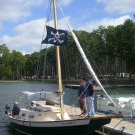
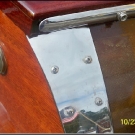
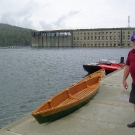
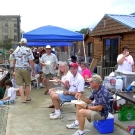
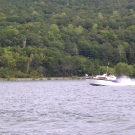
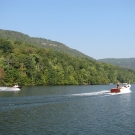
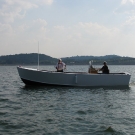
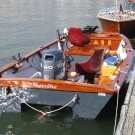

[…] A more serious Glossary of Boat Terms can be found on our website here. […]